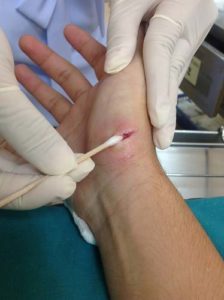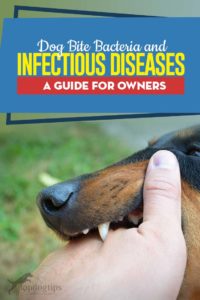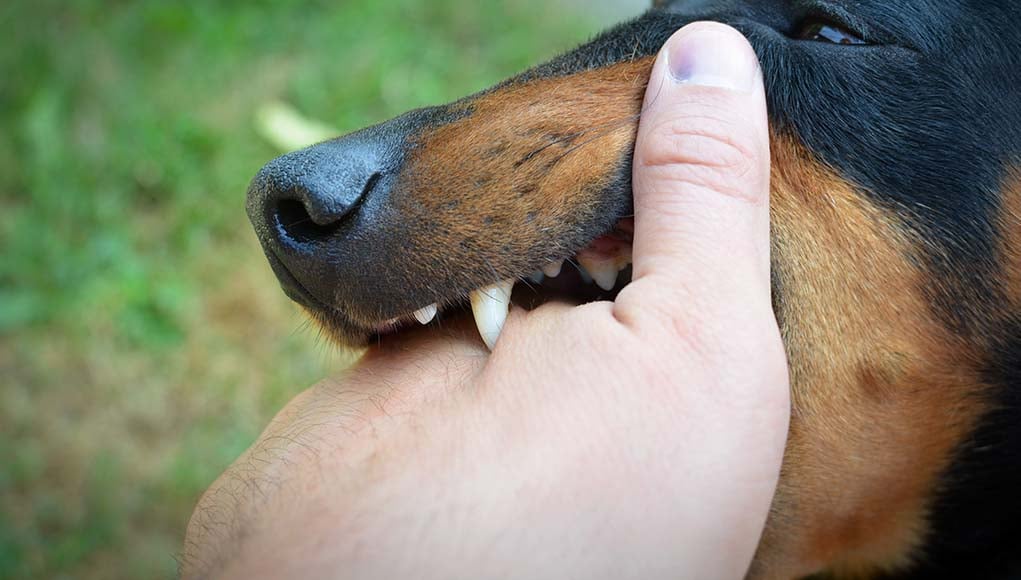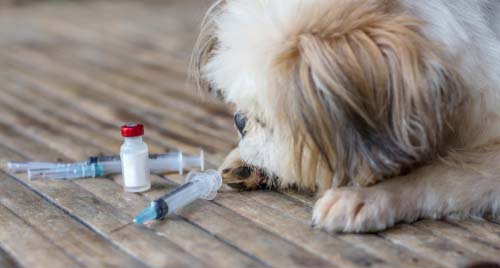Every year in the United States there are 4.5 million cases of dog bites. Dog bites make up 90% of all animal bites that take place in the United States, making dogs the most likely animal to bite and making dogs the second most dangerous animals in the U.S.
Children between the ages of 5 to 9 years-old are more likely to be bitten by a dog than individuals of any other age. The Center for Disease Control and Prevention (CDC) reports that up to 18% of dog bites will become infected, and more than 27,000 individuals who are bitten by a dog require reconstructive surgery each year.
ALSO READ: Dog on Dog Attack – How to Safely Break Up a Dog Fight
Dog Bite Bacteria and Infectious Diseases

1. Capnocytophaga
Spread through a dog’s saliva, capnocytophaga is a dangerous bacteria that's rarely contracted by humans, but when it is, it most often comes from a dog bite wound and can quickly become deadly.
The following symptoms of capnocytophaga should be watched out for after a dog bite: fever, vomiting, diarrhea, muscle and/or joint pain, headaches and/or confusion, and redness, swelling, blisters, and/or pus in or near the bite wound.
People with healthy immune systems may become infected by this dog bite bacteria, but it most commonly impacts individuals that have compromised immune systems, and those who have difficulty fighting off infections.
2. MRSA
MRSA bacteria, also known as methicillin-resistant Staphylococcus aureus, is a type of staph infection that can live in a dog’s mouth, and is transmitted to humans via a dog bite wound.
MRSA bacteria is fairly uncommon in the mouths of dogs and is not usually a huge concern or risk associated with dog bite wounds, but exposure to this bacteria can become serious and even deadly very quickly should someone who is bit by a dog get an infection from it.
If the MRSA infection remains only within the skin, it can usually be treated fairly easily and cleared up quickly; it is when the MRSA bacteria gets into a human’s blood stream via a deep dog bite wound that it becomes an extremely serious issue that, just like staph in dogs, can have a deadly outcome due to a person developing sepsis.
Humans and animals can carry MRSA without showing any signs, but if you have been bitten by a dog, watch out for the following signs that the MRSA bacteria is developing into a dangerous infection: a bump, boil, or infected looking area on the skin in or near the bite wound, as well as a fever, pain, warm or hot to the touch, redness, swelling, or discharge in or near the dog bite wound.
3. Pasteurella
This is the most common source of dog bite bacteria, and more than 50% of all infected dog bite wounds contain Pasteurella.
As with all of these bacterium induced conditions, it is more likely that individuals that have compromised immune systems due to either old age, illness or both, will have this bacteria spread quickly within their system and cause serious symptoms and side effects than individuals with healthy and uncompromised immune systems.
This infection develops rapidly, with the initial signs and symptoms of the bacterial infection showing up within 12 to 24 hours after exposure, including red, swollen, and tender areas in and around the dog bite wound, and can progress to swollen lymph nodes, swollen joints, difficulty moving, fevers, pneumonia, and meningitis if left untreated.
4. Rabies
It can take up to 6 months for humans and animals to show signs of being infected with the rabies virus, and unfortunately, once this viral infection has progressed enough to show symptoms, it is essentially 100% fatal, making it one of the most serious and dangerous infections that people can get from dog bites.
The initial signs that a dog might have rabies include their bark and vocal sounds changing, having difficulty swallowing, excessive drooling, and uncharacteristic or abnormal behavior. If your dog is behaving oddly, keep them away from other animals and humans and take them to see a licensed veterinarian as soon as possible.
Initial signs that a human might have contracted rabies through dog bite bacteria include the following: tingling, prickling, or itching sensations in or near the bite wound, as well as symptoms that are similar to those for the flu, such as fever, nausea, vomiting, diarrhea, loss of appetite, headache, muscle weakness, and being extra-tired.
After a few days post-exposure, more advanced and neurological symptoms such as the following can develop: excessive movement and/or agitation, sensitivity to bright sounds, light, and/or touch, convulsions and/or seizures, confusion, muscle spasms and abnormal posture, bizarre or strange thoughts and/or hallucinations, weakness and/or paralysis.
The most effective way to prevent rabies infections in dogs and humans is to have all dogs and humans vaccinated before the risk of exposure occurs, and prevent dogs and humans from being exposed to wild animals known to carry rabies (bats, skunks, raccoons, foxes). Post-bite vaccinations can work, but are much less effective, especially with individuals who have compromised immune systems due to age, illness, or both.
5. Tetanus
Contrary to popular belief, tetanus has nothing to do with rusty metal; it is actually caused by a toxic and poisonous bacterium named Clostridium tetani that lives and thrives in soil (dirt) and feces, and without oxygen, making it the perfect bacteria to get into an animal or human’s bloodstream through dirty, open, and deep wounds where soil and a lack of oxygen exist, such as dog bite wounds.
Similar to tetanus in dogs, the time period that it takes for tetanus in people to develop to the point where symptoms are beginning to appear can be anywhere between 3 to 21 days, with the average incubation period being 8 days post-exposure. The farther away the dog bite wound is from the central nervous system, the longer the incubation period will be and the shorter the incubation period is, the more dangerous the infection is, and the risk for death becomes exponentially higher as well.
Symptoms of tetanus include the following: irritability, jaw cramping and spasming, and/or general jaw stiffness or lock jaw, neck stiffness, trouble with swallowing, drooling, staring aimlessly and jerking behaviors (i.e., seizures), stiff abdominal muscles, sweating, chills, fever, increased heart rate, elevated blood-pressure, and painful muscle stiffness and spasms all over the body.
RELATED: 20 Dog Breeds With the Strongest Bite Force
What to Do If a Dog Has Bit You
 First, get away from the dog that has attacked you, and go to a safe place to assess the injury and prevent additional injury from occurring. Immediately apply gentle pressure to the wound to minimize, and help stop the bleeding, if there is any.
First, get away from the dog that has attacked you, and go to a safe place to assess the injury and prevent additional injury from occurring. Immediately apply gentle pressure to the wound to minimize, and help stop the bleeding, if there is any.
Second, thoroughly rinse out the wound with clean tap water or even better with purified water, hydrogen peroxide and a mild, fragrance-free soap. Pat the area dry with a clean cloth, apply a bit of antibiotic cream to the wound, then cover it with a sterile bandage; the bandage should be changed multiple times each day. Keep the wounded area of your body elevated as best as you can, as often as possible.
If it was not your dog that bit you, gather all of the necessary information from the dog’s owner, such as status of the dog’s shots, specifically their rabies shot and immunizations (if this is not possible, law enforcement personnel along with animal control and local veterinary hospitals and offices can help you to obtain this information).
An adult who has been bit by a dog can decide if he or she would like to see a doctor immediately (recommended) or not, but infants and children should always be seen by a doctor immediately after receiving a dog bite of any kind.
If the skin has not been broken by the dog bite and there's only minimal damage from the bite, it might be okay to wait and watch for any signs of infection or complications caused by the dog bite (such as redness, swelling, pain, oozing pus or fluid drainage of any kind), before seeking medical attention.
Dog bites can cause very serious damage to tissue and ligaments under the skin without visible signs of this appearing on the surface of the skin, but dog bite bacteria related diseases can be far more dangerous. If an individual who has been bitten by a dog starts to feel pain anywhere near the bite, even with no visible signs of damage, or if there is any kind of puncture wound or tear in the skin, go to the emergency room or urgent care center nearest to you to be evaluated, as soon as possible; the longer you wait, the higher the chances of infection and complications are.
How to Prevent Dog Bites from Happening
Never approach an unfamiliar dog.
Never try to separate dogs that are fighting.
Avoid contact with animals that are sick.
Never reach through or over a fence to pet a dog.
Never encourage your dog to play rough, or aggressively.
Before approaching a dog, always ask their owner if doing so is okay.
Never approach a dog quickly, and never approach a dog from above their head.
Give new, and also familiar and friendly dogs adequate time to come to you, sniff you, and acknowledge your presence before you acknowledge or pet the dog.
Never approach a dog while they're eating, sleeping, caring for puppies, playing with a toy, when the dog is growling, barking, or showing any signs of aggression, is acting anxious / agitated, or if the dog simply seems to want to be left alone. Always carefully observe a dog’s body language and behavior and respect what they are telling you.
If any sort of confrontation or stand-off situation with a dog takes place, never make eye-contact with the dog, and do not panic, run away, or scream.
If a strange dog approaches you say “No” and/or “Go Home” in a calm and confident voice, and always stand with the side of your body facing the dog and never make eye-contact, as both of these mannerisms can be seen as aggressive and threatening behaviors, by the dog. Put your purse, bag, or jacket between you and the dog.
If you are knocked down by a dog, curl up into a ball with your hands and arms protecting your head and neck as much as possible, and be as still and quiet as possible.
Teach ALL children how to properly and safely behave around, and respect dogs, and instruct them to always give a dog their space, even if the child doesn’t live with a dog.
All dog owners must spend more than enough time with their dogs so that the dogs do not become lonely, anxious, and/or depressed.
All dog owners must properly train and socialize their dogs to ensure that they are comfortable, secure, and obedient around other humans and animals.
All dog owners must properly exercise their dogs in order to keep them from having too much energy and getting agitated, and to also prevent their dogs from becoming overweight, which leads to health problems and pain, which leads to agitation and increased risk for dog bites.
All dog owners must feed their dogs a high-quality, well-balanced diet and take them to the vet as needed to ensure that their dog is healthy, and therefore not uncomfortable or in pain, which causes dogs to be more easily provoked and lash out due to pain, increasing the risk that they will bite.
 Never leave a child or infant unsupervised with a dog. Because children are the age group that dogs most commonly bite, and most often the child is bit by the family’s own dog. Therefore, it is imperative that families constantly supervise their children, and only adopt dogs that are breeds that are known to be calm, kind, and patient with children, if you have a child or infant in your home.
Never leave a child or infant unsupervised with a dog. Because children are the age group that dogs most commonly bite, and most often the child is bit by the family’s own dog. Therefore, it is imperative that families constantly supervise their children, and only adopt dogs that are breeds that are known to be calm, kind, and patient with children, if you have a child or infant in your home.
All dog owners must educate themselves to know and understand how to properly discipline their dogs without the use of verbal or physical intimidation or violent, harmful correction behaviors.
READ NEXT: Why Are Dogs More Prone to Bite Nervous People?


















